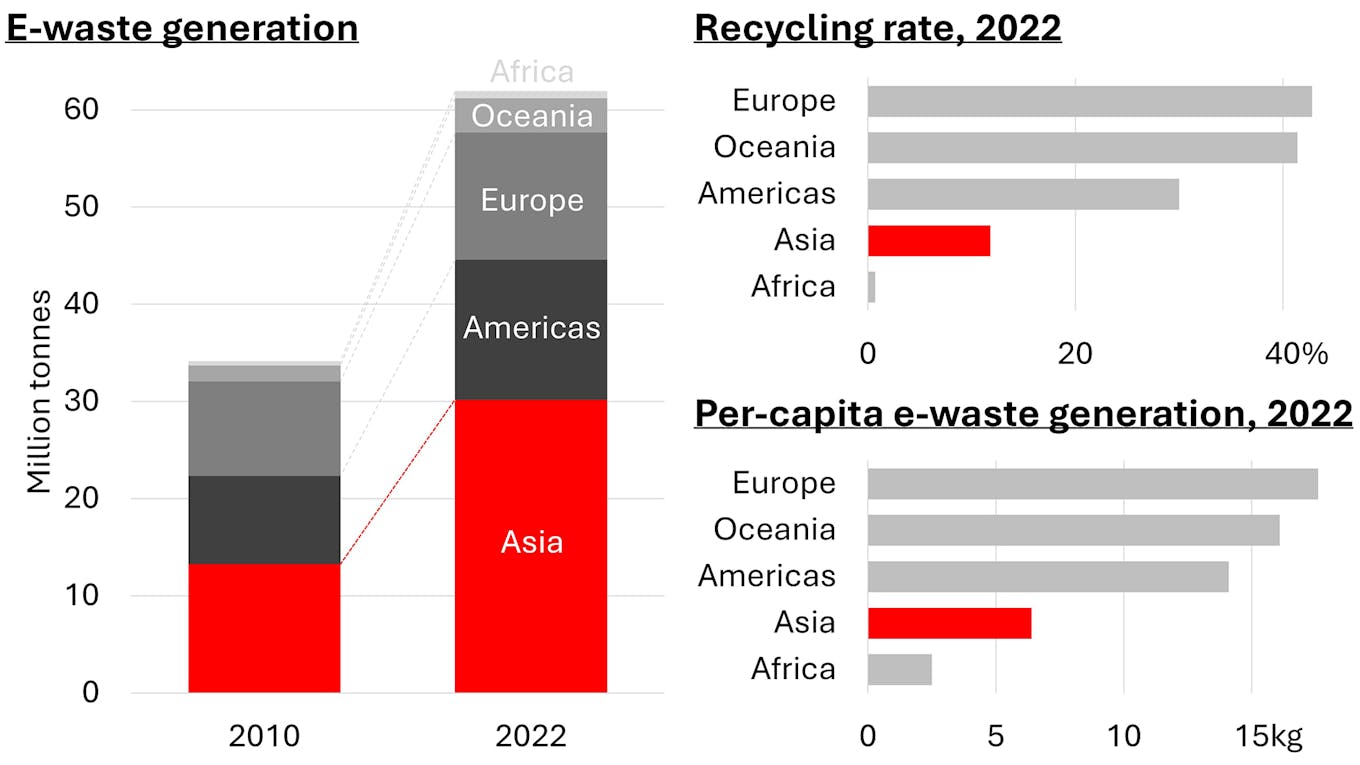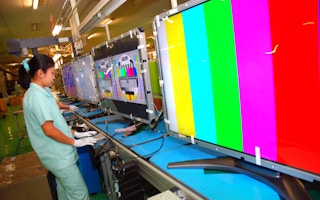Asia accounted for almost half of all electronic waste discarded worldwide in 2022, but contributed to only a quarter of global e-waste recycling, according to data from a United Nations study published Wednesday.
To continue reading, subscribe to Eco‑Business.
There's something for everyone. We offer a range of subscription plans.
- Access our stories and receive our Insights Weekly newsletter with the free EB Member plan.
- Unlock unlimited access to our content and archive with EB Circle.
- Publish your content with EB Premium.
Southeast Asia is also increasingly taking in more e-waste from its neighbours, despite its own low recycling rates and often informal nature of refuse collection, the report said, pointing to growing environmental and health challenges that result from e-waste dumping in the region.
The global picture isn’t bright either – the volume of discarded devices is on a steady, linear climb, with documented recycling rates lagging that growth by five times. A record 62 million tonnes of e-waste was produced in 2022, of which under 14 million tonnes were properly recovered.

Eco-Business graphics. Data: United Nations Institute for Training and Research.
The volume pales in comparison to other waste streams, such as plastics or food, but the improper disposal of electronic gadgets present its own complex mix of environmental problems. Leaked lead and mercury cause serious health issues. Coolants leaching from old refrigerators are thousands of times more powerful than carbon dioxide in heating the Earth. Rare earth metals that are not recovered from complex machinery represent a lost opportunity to reduce the need for destructive mining activities.
“No more than 1 per cent of demand for essential rare earth elements is met by e-waste recycling. Simply put: business as usual can’t continue,” said report lead author Kees Balde.
“This new report represents an immediate call for greater investment in infrastructure development, more promotion of repair and reuse, capacity building, and measures to stop illegal e-waste shipments. The investment would pay for itself in spades,” Balde added.
The Asian challenge
Asia generated 30 million tonnes of e-waste and formally recovered less than 12 per cent of it in 2022, the UN report found. Documented recycling rates vary markedly in the region: 20 per cent for East Asia, 1 per cent for South Asia, and 0 per cent for Southeast Asia.
Out of 49 Asian countries analysed, 18 countries have e-waste policies and just four (China, Japan, Cyprus and Turkey) have recycling targets, figures the report said represented “limited advances” in managing the deluge of old appliances. In contrast, most of Europe, which topped the charts with an almost 43 per cent recycling rate, regulates e-waste and has recycling targets.
East Asia is a major importer of e-waste, receiving over 85,000 tonnes of used gadgets from around the world. The region, led by China, Japan and South Korea, is largely able to process the consignments, the report noted.
But Southeast Asia, which does not have such capacity, is also receiving increasing volumes of e-waste from East Asia and North America. Such trade could be driven by demand for cheap used or counterfeit gadgets, which then quickly becomes waste due to their shorter lifespan, the report said. It added that illegal shipments also benefit from global trade classification systems that do not differentiate second-hand electronic goods from prohibited e-waste.
Asia currently shoulders less responsibility for the global e-waste burden on a per-capita basis: the continent generated 6.4 kilogrammes of e-waste per person in 2022, almost three times less than in Europe. But the gap could close in the years ahead.
“Asia is growing economically, and a greater number of people are entering into the consumption economy,” said Professor Seeram Ramakrishna, a mechanical engineering and circular economy expert at the National University of Singapore.
“Hence, we can expect to see growing consumption of e-products and generation of e-waste in Asia. Their effects on human health and ecology can no longer be ignored,” Ramakrishna said.
He added that the challenge is compounded by a “chicken and egg” problem in funding new technologies, where investors are sceptical about the viability of large e-waste recycling efforts since existing players are mainly small and medium-sized businesses.
Ambition pays
In 2022, the world lost US$37 billion as a result of the low e-waste recycling rate, factoring in the resultant global warming, higher healthcare spending to address toxic leakage and lost value in metals that could have been recovered. Losses could extend to US$40 billion annually by 2030, when the global recycling rate is expected to dip to 20 per cent, the UN report estimated.
However, an “ambitious” effort to raise the global recycling rate to 44 per cent by 2030 would turn the losses into a US$10 billion gain instead, with the avoided health and environmental impacts outweighing investments to scale up e-waste management. This scenario is said to require voluntary collection schemes, the formalisation of waste management in developing countries, and stronger government mandates.
The report also floats an “aspirational” 60 per cent recycling target – an effort that will require rich countries to recover 85 per cent of their e-waste, and other jurisdictions targeting 40 per cent. The reward is a net US$38 billion gain, though much of the benefits could still be locked up in wealthy countries, the report warned.
Ramakrishna said he is optimistic that recycling rates will increase, as there is now greater pressure on decarbonising traditional mining activities, while higher carbon taxes will make virgin materials more expensive. Geopolitical supply chain disruptions in valuable minerals are also creating impetus for resource independence via recycling, he said.
Still, stringent regulations, greater funding and research, along with cross-border Asian partnerships are needed to make recycling projects viable, he added.
Regardless of future scenarios, the UN report warns that policymakers will need to tackle a new waste stream – discarded solar panels are expected to quadruple to 2.4 million tonnes by 2030. There is a rise of small-scale off-grid solar products with short lifespans of under four years in developing nations, and more effort needs to go into repairing rather than discarding them, the report said.
“Amidst the hopeful embrace of solar panels and electronic equipment to combat the climate crisis and drive digital progress, the surge in e-waste requires urgent attention,” said Nikhil Seth, executive director of the UN Institute for Training and Research, which produced the study.










